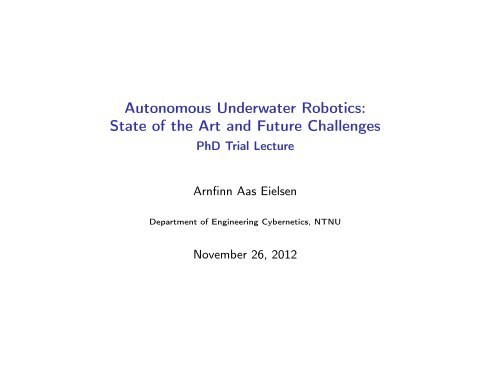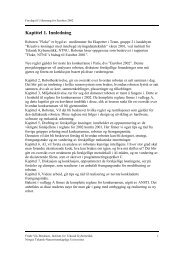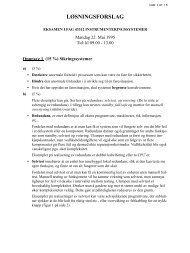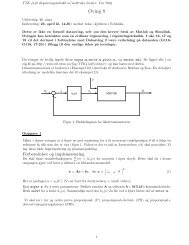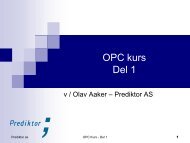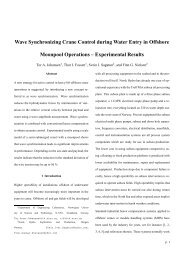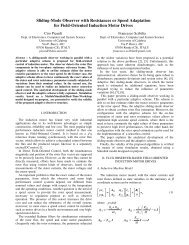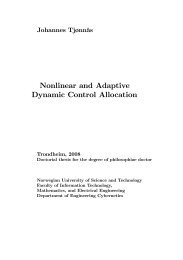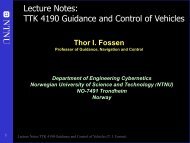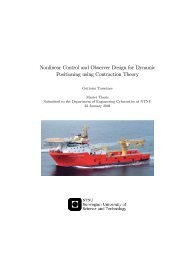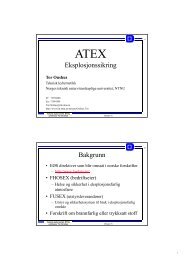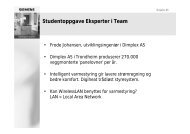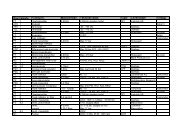Trial Lecture - NTNU
Trial Lecture - NTNU
Trial Lecture - NTNU
Create successful ePaper yourself
Turn your PDF publications into a flip-book with our unique Google optimized e-Paper software.
Autonomous Underwater Robotics:<br />
State of the Art and Future Challenges<br />
PhD <strong>Trial</strong> <strong>Lecture</strong><br />
Arnfinn Aas Eielsen<br />
Department of Engineering Cybernetics, <strong>NTNU</strong><br />
November 26, 2012
Outline<br />
Introduction<br />
Goals and Motivations<br />
Groups/Projects With Recent Publications<br />
Modeling<br />
Low-Level Control<br />
Sensor Systems<br />
Simultaneous Localization And Mapping (SLAM)<br />
Other Topics<br />
Conclusions<br />
References
Definitions<br />
Underwater robotics typically refers to Unmanned Underwater Vehicles (UUVs).<br />
At this time, two types of UUVs are in common usage:<br />
◮<br />
◮<br />
Remotely Operated Vehicles (ROVs)<br />
Autonomous Underwater Vehicles (AUVs)<br />
Remotely Operated Vehicles (ROVs) are tele-operated vehicles, that can be used<br />
to perform inspection and intervention missions under water, by being a mobile<br />
platform for sensors and manipulators.<br />
An ROV is an Underwater Vehicle-Manipulator System (UVMS).<br />
Autonomous Underwater Vehicles (AUVs) are autonomous vehicles, which are<br />
used as mobile sensor platforms that can undertake survey and inspection<br />
missions under water, without human interaction.<br />
Autonomous underwater robotics, is here defined as an autonomous UVMS.<br />
Essentially: combining the capabilities of ROVs and AUVs.
Applications<br />
Dirty – Dangerous – Distant – Dull<br />
Examples of areas:<br />
◮<br />
◮<br />
◮<br />
Deep water (adverse conditions for communication to surface)<br />
Under ice (inaccessible area for surface vehicles)<br />
Nuclear plant fuel rod storage tanks (hazardous environment)<br />
Examples of tasks:<br />
◮<br />
◮<br />
◮<br />
◮<br />
◮<br />
◮<br />
Salvage and recovery/retrieval (clearing debris, retrieving objects)<br />
Inspection (fish farming, mine detection, pipeline and hull inspection)<br />
Intervention on subsea installations (valve operations, pipeline repair)<br />
Survey (seafloor mapping, seismology, oceanography)<br />
Observation (aiding undersea rescue, threat detection, marine biology)<br />
Communications (placing acoustic markers, relaying)<br />
Yuh et al. [2011], Sheridan and Verplank [1978]
Examples of Existing AUVs<br />
(a) The Hybrid ROV Nereus (Woods<br />
Hole Oceanographic Institute).<br />
(b) HUGIN (Kongsberg Maritime).<br />
(c) The Bluefin HAUV prototype<br />
(Bluefin Robotics Corporation).<br />
(d) Webb Research Thermal Glider<br />
(Teledyne Webb Research).<br />
(e) RoboLobster (Office of Naval<br />
Research).<br />
(f) Robofish (University of<br />
Washington).<br />
Yuh et al. [2011], Morgansen et al. [2007]
Applications<br />
An ROV performing a valve operation on a subsea structure.<br />
Source: Frank van Mierlo (Public Domain)
Goal<br />
An overall goal for unmanned vehicles is increased autonomy.<br />
Essentially getting rid of the infrastructure needed for tele-operation, expanding<br />
the capabilities of underwater robotics.<br />
Source: Schilling Robotics
Motivations<br />
Use of ROVs is limited due to:<br />
◮<br />
◮<br />
◮<br />
◮<br />
◮<br />
◮<br />
◮<br />
very high operational costs (approx. €8000 per day)<br />
large crew and specialized mother vessel (dynamic positioning)<br />
can not operate in ice covered areas<br />
operator fatigue (even with auto-heading, auto-depth, etc.)<br />
practical and safety issues (tether management)<br />
time-delay in human-machine interaction (loss of precision)<br />
limited depth (limited capability of tether and pressure hull)<br />
Yuh and West [2001], Antonelli et al. [2008], Antonelli [2006], Yuh et al. [1998], Prats et al. [2011a],<br />
Sheridan and Verplank [1978]
Autonomy – Definitions<br />
Types of autonomy:<br />
◮<br />
◮<br />
◮<br />
Energy autonomy: reliable power sources and low power consumption<br />
Navigation autonomy: localization without estimate error growth<br />
Decision autonomy: solving tasks and fault detection and tolerance<br />
Levels of automation/autonomy:<br />
HIGH 10 The computer decides everything and acts autonomously,<br />
ignoring the human.<br />
9 Informs the human only if it, the computer, decides to.<br />
8 Informs the human only if asked, or<br />
7 executes automatically, then necessarily informs the human, and<br />
6 allows the human a restricted time to veto before automatic<br />
execution, or<br />
5 executes the suggestion if the human approves, or<br />
4 suggest one alternative.<br />
3 Narrows the selection down to a few, or<br />
2 the computer offers a complete set of decision/action alternatives, or<br />
LOW 1 the computer offers no assistance:<br />
human must take all decision and actions.<br />
Parasuraman et al. [2000], Sheridan and Verplank [1978], Hagen et al. [2009]
Autonomy – Goals<br />
The overall goal for autonomous UVMSs is to be able to issue very high-level<br />
commands, e.g.,<br />
“move from location A to location B”, “inspect the pipeline”, “unplug the<br />
connector”, “retrieve the treasure chest from the sunken pirate ship”<br />
without having to specify all the sub-task needed to solve the mission (like to<br />
ROV operator does now, or the the driver or a car).<br />
Best current examples might be the EUREKA Prometheus Project, DARPA<br />
Grand Challenge, and the Google Driverless Car.<br />
Intermediate goals will be to find ways to assist ROV operators<br />
(semi-autonomy); letting the ROV operators focus on higher level tasks, rather<br />
than controlling everything.<br />
Station keeping/dynamic positioning, automatically solving kinematic redundancy<br />
and trajectory generation problems, compensating for time-delay (augmented<br />
reality, “predictor diplays”), ...<br />
Luettel et al. [2012], Yuh and West [2001], Hagen et al. [2009], Marani et al. [2009], Wang et al. [1995],<br />
Prats et al. [2012a], Candeloro et al. [2012], Sheridan and Verplank [1978]
Research Areas – Autonomous Underwater Robotics<br />
Related to control engineering<br />
◮<br />
◮<br />
◮<br />
◮<br />
◮<br />
Modeling + robust and adaptive control + singularity free representations<br />
Sensor fusion + disturbance estimation/rejection<br />
Computer vision + simultaneous localization and mapping (SLAM)<br />
Trajectory planning + obstacle avoidance + kinematic redundancy<br />
Mission control systems (high-level control)<br />
Other examples (computer science, electrical, mechanical, chemical, ...):<br />
Sensors, imaging, machine vision, real-time operating systems, dexterous<br />
manipulator systems, efficient thrusters, lightweight structures, high-density<br />
power sources, virtual reality, human machine interfaces, artificial intelligence, ...<br />
Overlapping with research in other fields, especially other mobile robots:<br />
◮ Unmanned Ground Vehicles (UGVs)<br />
◮ BigDog (Boston Dynamics)<br />
◮ Google Driverless Car (Google)<br />
◮ Sojourner (NASA)<br />
◮ Unmanned Aerial Vehicles (UAVs)<br />
◮ Black Hornet (Prox Dynamics)<br />
◮ Predator (General Atomics)
Groups/Projects With Recent Publications<br />
TRIDENT/RAUVI (Reconfigurable Autonomous Underwater Vehicle for<br />
Intervention Missions)<br />
Co-ordinated by University of Jaume I, Castellón de la Plana, Spain<br />
◮ Vehicle: Girona 500<br />
◮<br />
3 to 8 thrusters + 4 DOF manipulator (ARM5E)<br />
◮ Final sea trials in October 2012<br />
SAUVIM (Semi-Autonomous Underwater Vehicle for Intervention Missions)<br />
University of Hawaii at Manoa, USA<br />
◮ 8 thrusters + 7 DOF manipulator (MARIS 7080)<br />
◮ Sea trials in January 2010<br />
ALIVE (Autonomous Light Intervention VEhicle)<br />
Hitec Framnæs, Cybernetix, Ifremer, Heriot-Watt University, Joint Research<br />
Centre (European Commission)<br />
◮<br />
5 thrusters + 6 DOF manipulator<br />
◮ Sea trials in October 2003<br />
Marani et al. [2009], Prats et al. [2012a], Evans et al. [2003], Prats et al. [2011a]
Movies - ALIVE<br />
The movies demonstrate several features:<br />
◮<br />
◮<br />
◮<br />
◮<br />
◮<br />
◮<br />
Localization using acoustic signals.<br />
Navigating to the proximity of the target.<br />
Finding the target and approaching.<br />
Visual servo control for station keeping.<br />
Disturbance rejection, compensating for underwater current.<br />
Visual servo control for manipulating/interacting with an ROV panel (valve<br />
operations).<br />
http://www.youtube.com/watch?v=NuVG15Sf9U0
Movies - TRIDENT<br />
◮<br />
◮<br />
◮<br />
◮<br />
◮<br />
◮<br />
◮<br />
Surveying – simultaneous<br />
localization and mapping (SLAM).<br />
Localization using maps, INS, DVL.<br />
Navigating to the proximity of the<br />
target.<br />
Finding the target and approaching.<br />
Visual servo control for station<br />
keeping.<br />
Visual servo control for interacting<br />
with and retrieving a Black Box<br />
mock-up.<br />
Virtual/augmented reality for<br />
mission control.<br />
Not shown: Synchronous motion with<br />
surface vessel (for SLAM).<br />
http://www.youtube.com/watch?v=jdt_Gy-YjUI<br />
Prats et al. [2011b]
Hardware Architecture – SAUVIM<br />
Kim and Yuh [2004]
Software Architecture – RAUVI<br />
Prats et al. [2012b]
Modeling<br />
Vehicle dynamics:<br />
φ (roll)<br />
υ (surge)<br />
M v ˙ν + C v(ν)ν + D v(ν)ν + g v(RB) I = τ v<br />
[ ]<br />
ν = ν T T<br />
T<br />
1 , ν 2 = [u, v, w, p, q, r]<br />
T<br />
ν = J e(RB) I ˙η ⇒ ˙η = J −1 e (RB)ν<br />
I<br />
[ ]<br />
η = η T T<br />
T<br />
1 , η 2 = [x, y, z, φ, θ, ψ]<br />
T<br />
θ (pitch)<br />
υ (sway)<br />
yb<br />
ψ (yaw)<br />
ω (heave)<br />
zb y<br />
η1<br />
z<br />
x b<br />
x<br />
Vehicle-manipulator dynamics:<br />
M(¯q) ˙ζ+C(¯q, ζ)ζ+D(¯q, ζ)ζ+g(¯q, R I B) = τ<br />
y b<br />
x b<br />
ζ =<br />
[ν T 1 , ν T 2 , ˙¯q T] T<br />
z b<br />
Euler angle representation has<br />
singularities → non-minimal<br />
representations such as quaternions<br />
y<br />
z<br />
x<br />
x 1<br />
z n<br />
y n<br />
x n<br />
Antonelli et al. [2008], Antonelli [2006], Feldman [1979]<br />
y 1<br />
z 1
Modeling – Some Properties<br />
Due to hydrodynamic effects, the mass matrix must include added mass. e.g.:<br />
M =<br />
M<br />
} {{ RB<br />
}<br />
+ M<br />
}{{} A<br />
rigid body added mass<br />
Similarly for the Coriolis and centripetal contribution, e.g.:<br />
C = C RB + C A<br />
The damping matrix D should include hydrodynamic damping effects:<br />
◮<br />
◮<br />
◮<br />
◮<br />
skin friction<br />
vortex shedding damping<br />
viscous damping (drag and lift)<br />
(surface: potential damping + wave drift damping)<br />
Currents is a major disturbance under water. Assumed to be irrotational and<br />
constant. Included by considering the relative velocity ν r.<br />
[ ]<br />
νc I I T T<br />
= v c1 , 0<br />
T ⇒ νr = ν − RI B νc<br />
I<br />
Gravity and buoyancy forces are added to the vector g(¯q, R I B).<br />
Antonelli et al. [2008], Antonelli [2006]
Modeling – Some Properties<br />
For a fully actuated UVMS:<br />
◮ the inertia matrix is symmetric and positive definite, M = M T > 0<br />
◮ the damping matrix is positive definite, D > 0<br />
◮ the matrix Ṁ − 2C is skew symmetric, Ṁ − 2C = −(Ṁ − 2C)T<br />
But only for certain symmetry and parametrization assumptions!<br />
☺ Good: Linearity in parameters (no current):<br />
Φ(¯q, R I B, ζ, ˙ζ)θ = τ<br />
θ ∈ R n θ<br />
☹ Bad: Model complexity/order:<br />
◮ Single rigid body (e.g. vehicle): n θ,v > 100.<br />
◮ UVMS: n θ = (n + 1)n θ,v .<br />
Antonelli et al. [2008], Antonelli [2006], From et al. [2012]
Modeling – Thrusters<br />
◮<br />
◮<br />
◮<br />
◮<br />
Thruster dynamics is non-linear (not ideal force generators, i.e. not<br />
instantaneous and linear).<br />
◮ Behaves like a sluggish non-linear filter.<br />
◮ Limited power → force saturation.<br />
◮ Can cause limit-cycling under closed-loop control.<br />
For smaller/lighter vehicles and manipulators, the impact of the<br />
“time-constant” and non-linearity can be a significant.<br />
For UVMSs, the vehicle should be fully actuated, to counteract interaction<br />
forces when using the manipulator.<br />
There should be thruster redundancy for failure tolerance → need methods<br />
for thruster allocation.<br />
Yoerger et al. [1990], Healey et al. [1995], Antonelli et al. [2008], Antonelli [2006]
Modeling – Challenges<br />
◮<br />
◮<br />
◮<br />
◮<br />
◮<br />
◮<br />
uncertainty<br />
◮ poor knowledge of hydrodynamic effects<br />
◮ difficulty of parameter identification<br />
◮ changes due to payload (mission-to-mission or during mission)<br />
validity of model is limited to low velocities<br />
complexity and/or order of the model<br />
kinematic redundancy<br />
singularity free representations<br />
lack of thruster modeling (poor thruster performance)<br />
Antonelli et al. [2008], Antonelli [2006], Sørensen and Refsnes [2009], Yuh and West [2001]
Low-Level Control<br />
Currently (SAUVIM + TRIDENT/RAUVI) proportional-integral-derivative (PID)<br />
control or feed-forward control is used for vehicle and manipulator control.<br />
PID control can take the form (for the vehicle, using quaternions, but usually<br />
done using Euler angles):<br />
∫ t<br />
τ v = ĝ v(RB)<br />
I +K D ˙˜p + K P ˜p + K I ˜p(t ′ )dt ′<br />
} {{ }<br />
0<br />
optional<br />
[<br />
p = η T 1 Q T] [ ]<br />
T<br />
∈ R 7 η1,d − η 1<br />
, ˜p =<br />
Im( ¯Q d · Q)<br />
The optional term improves transient response of sluggish integral action<br />
(e.g. for yaw motion due to buoyancy and gravitation).<br />
The coupling from the manipulator can be compensated using:<br />
¯τ v = τ v + ˆτ m(R I B, q, ζ, ˙ζ)<br />
The assumption is then that the manipulator has a fixed base, and regular<br />
manipulator control schemes are used (kinematic and dynamic control).<br />
Prats et al. [2012b], Marani et al. [2009], Antonelli [2006], From et al. [2010]
Low-Level Control<br />
Challenges:<br />
◮<br />
large model uncertainty (time-varying, poor parameter estimation)<br />
◮ disturbances (underwater currents, interaction forces, ...)<br />
◮<br />
dynamic coupling between the vehicle and the manipulator<br />
To improve performance, several non-linear control schemes have been proposed,<br />
based on, e.g.:<br />
◮ sliding-mode/variable structure<br />
Also:<br />
◮ backstepping<br />
◮ neural-networks<br />
◮ feedback linearization<br />
◮ fuzzy logic<br />
Basis for adaptive control laws and reduced order control laws.<br />
Challenges:<br />
◮<br />
◮<br />
◮<br />
persistency of excitation<br />
high model complexity and/or order<br />
state estimates (observers)<br />
Antonelli [2006], Sørensen and Refsnes [2009], Yuh and West [2001], Antonelli et al. [2008], Jordan and<br />
Bustamante [2009], Antonelli et al. [2004a]
Sensor Systems<br />
Autonomous operation requires perception of the vehicle’s local environment.<br />
Pigeon: keen eyesight + learning capabilities<br />
(vs. Manual Control to Line of Sight)<br />
Skinner [1960], Wasserman [1995]
Sensors Used for Perception (Mission Specific)<br />
Sensors are used to:<br />
◮<br />
enable motion control (position measurement/localization)<br />
◮ perform a specific mission (inspection, survey, observation, targeting, ...)<br />
Mission specific sensors (underwater manipulation):<br />
◮<br />
◮<br />
cameras (two for stereo vision)<br />
sonars (various configurations)<br />
Basis for computer vision, and is used for visual servo control to provide<br />
measurements to solve a task (relative position, shapes, colors, orientation, ...)<br />
Examples of tasks: station keeping, pipeline tracking, recovering objects, valve<br />
operations, clearing debris, welding, ...<br />
Prats et al. [2012b], Antonelli et al. [2008], Marani and Choi [2010], Prats et al. [2011a], Horgan and<br />
Toal [2009], Hutchinson et al. [1996]
Simultaneous Localization And Mapping (SLAM)<br />
Simultaneous Localization And Mapping (SLAM): build a map of an unknown<br />
environment and at the same time use this map to navigate.<br />
A key prerequisite for truly autonomous navigation.<br />
It is used by the high-level control layer (mission control) for<br />
◮<br />
◮<br />
◮<br />
◮<br />
◮<br />
surveying<br />
finding targets of interest<br />
path planning to target<br />
obstacle avoidance<br />
planning the solution of a task<br />
◮ ...<br />
Extracts features (“landmarks”) from image data and correlates them with<br />
position measurements (sensor fusion).<br />
Luettel et al. [2012], Ferreira et al. [2012], Ribas et al. [2008], Ferreira et al. [2011],<br />
Durrant-Whyte and Bailey [2006]
Simultaneous Localization And Mapping (SLAM)<br />
Prats et al. [2012b]
Sensors Used for Localization and Navigation (Motion Control)<br />
Compass: Measures heading relative to geodetic north (gyro compass) or<br />
magnetic north (magnetic compass).<br />
Inertial Measurement Unit (IMU): Provides measurements of linear acceleration<br />
and angular velocity (using accelerometers, gyroscopes, and magnetometers).<br />
Depth sensor: Pressure measurement that can be translated to a vehicle depth.<br />
Altitude and forward-looking sonar: Length measurements to seafloor and<br />
objects.<br />
Doppler Velocity Log (DVL): Measures vehicle velocity relative to the seafloor<br />
and relative water motion.<br />
Global Navigation Satellite System (GNSS): Used to localize the vehicle on the<br />
surface and to initialize the IMU. (Only works on the surface.)<br />
Acoustic positioning: Measures position relative to transponders.<br />
Long BaseLine (LBL), Short BaseLine (SBL), Ultra Short BaseLine (USBL).<br />
SLAM: Position measurements relative to map features.<br />
Kinsey et al. [2006], Ribas et al. [2008], Corke et al. [2007], Grenon et al. [2001], Hunt et al. [1974]
Sensor Fusion<br />
Truly Autonomous 131<br />
Block diagram of the HUGIN integrated inertial navigation system.<br />
SAS CVL<br />
Reset<br />
Delta<br />
Position<br />
DVL<br />
Velocity<br />
(in B)<br />
Gyros<br />
Accelerometers<br />
IMU<br />
Angular<br />
velocity<br />
Specific<br />
force<br />
INS<br />
Navigation<br />
Equations<br />
Decompose<br />
in L<br />
_<br />
Velocity (in L)<br />
Horizontal<br />
position<br />
Attitude<br />
Depth<br />
Compass<br />
_<br />
_<br />
Pressure<br />
sensor<br />
_<br />
Error state<br />
Kalman<br />
filter<br />
◮<br />
◮<br />
◮<br />
◮<br />
CVL – Correlation Velocity Log<br />
(velocity)<br />
DVL – Doppler Velocity Log<br />
(velocity)<br />
DGPS – Differential GPS<br />
(position)<br />
USBL – Ultra Short BaseLine<br />
(position)<br />
DGPS +<br />
USBL<br />
GPS<br />
Terrain<br />
Navigation<br />
Range<br />
(+bearing)<br />
Underwater<br />
transponder<br />
positioning<br />
Estimates<br />
(of errors in<br />
navigation<br />
equations and<br />
colored sensor<br />
errors)<br />
diagram Hagen of et the al. HUGIN [2009] integrated inertial navigation system.
Sensors Systems – Challenges<br />
◮<br />
◮<br />
◮<br />
◮<br />
Low bandwidth of the sensor readings.<br />
Lack of precision (and bandwidth) deteriorates manipulator performance.<br />
Errors and noise in measurements:<br />
◮ IMU and compass bias<br />
◮ acoustic signals affected by water temperature, pressure, and salinity<br />
◮ SLAM, DVL and sonar only work close to seafloor<br />
◮ low visibility and occlusion<br />
Fault tolerance (sensor redundancy).<br />
◮ Non-linear models in sensor fusion (extended/unscented Kalman filter +<br />
particle filter + non-linear observers).<br />
◮<br />
Computational requirements (computer vision, SLAM, and sensor fusion).<br />
SLAM must handle increasingly unstructured environments in situations where<br />
GPS-like solutions (e.g. acoustic transponders) are unavailable or unreliable.<br />
Underwater environment the most challenging for SLAM due to reduced sensorial<br />
possibilities and lack reliable features.
Other Topics<br />
◮<br />
◮<br />
◮<br />
◮<br />
◮<br />
◮<br />
◮<br />
◮<br />
Fault Detection and Tolerance<br />
◮ Few results due to lack of good models<br />
Guidance and Trajectory Generation<br />
◮ Optimization methods<br />
◮ Waypoints and Line of Sight<br />
Multiple Vehicles and Synchronization<br />
◮ Platooning<br />
◮ Relaying<br />
Communications<br />
◮ Low bandwidth for acoustic modems<br />
◮ Limited range (relaying)<br />
Mission Control<br />
◮ Mission planning and specification<br />
◮ Architectures for autonomous operation<br />
Artificial intelligence<br />
Real-time operating systems<br />
Semi-autonomous operation<br />
◮ Relieving operators (simplifying operations and preventing fatigue)
Conclusions – State of the Art<br />
◮<br />
◮<br />
◮<br />
ALIVE + SAUVIM + TRIDENT/RAUVI<br />
Experimentally proven autonomous UVMSs<br />
Fairly basic methods:<br />
◮ Control – PID<br />
◮ Sensor fusion – simple models and Kalman filters<br />
◮ Computer vision – well defined geometrical shapes<br />
◮ Autonomy – Petri nets (finite state machines)<br />
◮ Kinematic redundancy – limiting the workspace<br />
◮ ...
Conclusions – Future Challenges<br />
◮<br />
◮<br />
◮<br />
◮<br />
◮<br />
◮<br />
◮<br />
Mathematical modeling<br />
◮ Singularity free representations<br />
◮ Kinematic redundancy<br />
◮ Thrusters<br />
◮ Complexity<br />
◮ Uncertainty<br />
◮ Correct modeling retaining good model properties<br />
(boundedness and skew-symmetry)<br />
More advanced or different control laws<br />
◮ Adaptive, robust, lower order (e.g. L 1 -adaptive)<br />
Sensor systems (bounded error growth)<br />
Non-linear observers (e.g. particle filters)<br />
Fault detection<br />
Simultaneous localization and mapping (SLAM)<br />
Autonomy (simple task specification and more intelligent behavior)<br />
Yuh and West [2001], Antonelli et al. [2008], Antonelli [2006], Yuh et al. [1998], Prats et al. [2011a]
References I<br />
G. Antonelli. Underwater Robots, volume 2 of Springer Tracts in Advanced Robotics. Springer, 2nd edition, 2006.<br />
G. Antonelli, F. Caccavale, and S. Chiaverini. Adaptive Tracking Control of Underwater Vehicle-Manipulator Systems<br />
Based on the Virtual Decomposition Approach. Robotics and Automation, IEEE Transactions on, 20(3):594–602,<br />
June 2004a.<br />
G. Antonelli, S. Chiaverini, and S. Costantini. An experimental implementation or sensor fusion for mobile robots<br />
based on kalman filtering. In World Automation Congress, 2004 Proceedings of the, pages 479–484, Seville, June<br />
2004b.<br />
G. Antonelli, T. I. Fossen, and D. R. Yoerger. Underwater Robotics. In B. Siciliano and K. Oussama, editors,<br />
Handbook of Robotics, pages 987–1007. Springer, 2008.<br />
F. Arrichiello, H. K. Heidarsson, S. Chiaverini, and G. S. Sukhatme. Cooperative caging and transport using<br />
autonomous aquatic surface vehicles. Intelligent Service Robotics, 5(1):73–87, Dec. 2011.<br />
T. Bailey and H. Durrant-Whyte. Simultaneous Localization and Mapping (SLAM): Part II. IEEE Robotics &<br />
Automation Magazine, 13(3):108–117, Sept. 2006.<br />
A. Bonchis, N. Hillier, J. Ryde, E. Duff, and C. Pradalier. Experiments in Autonomous Earth Moving. In 18th IFAC<br />
World Congress, Proceedings of the, pages 11588–11593, 2011.<br />
M. Breivik and T. I. Fossen. Guidance Laws for Autonomous Underwater Vehicles. In A. V. Inzartsev, editor,<br />
Underwater Vehicles, pages 51–76. InTech, Jan. 2009.<br />
N. A. Brokloff. Matrix Algorithm for Doppler Sonar Navigation. In OCEANS 1994, Proceedings of, pages 378–383,<br />
1994.<br />
J. Brown, C. Tuggle, J. MacMahan, and A. Reniers. The use of autonomous vehicles for spatially measuring mean<br />
velocity profiles in rivers and estuaries. Intelligent Service Robotics, 4(4):233–244, July 2011.<br />
M. Caccia, G. Bruzzone, F. Ferreira, and G. O. . E. Veruggio. Online video mosaicing through SLAM for ROVs.<br />
OCEANS 2009 - EUROPE, pages 1–6, 2009.<br />
M. Candeloro, A. J. Sørensen, S. Longhi, and F. Dukan. Observers for Dynamic Positioning of ROVs with<br />
Experimental Results. In MCMC 2012, pages 1–6, 2012.<br />
G. Casalino, A. Caiti, A. Turetta, and E. Simetti. RT2: real-time ray-tracing for underwater range evaluation.<br />
Intelligent Service Robotics, 4(4):259–270, June 2011.<br />
T. Chatchanayuenyong and M. Parnichkun. Neural network based-time optimal sliding mode control for an<br />
autonomous underwater robot. Mechatronics, 16(8):471–478, Oct. 2006.<br />
F. Chaumette and S. Hutchinson. Visual Servo Control Part I: Basic Approaches. IEEE Robotics & Automation<br />
Magazine, 13(4):82–90, Dec. 2006.
References II<br />
F. Chaumette and S. Hutchinson. Visual Servo Control Part II: Advanced Approaches. IEEE Robotics & Automation<br />
Magazine, 14(1):109–118, Mar. 2007.<br />
M. Chitre, S. Shahabudeen, and M. Stojanovic. Underwater acoustic communications and networking: Recent<br />
advances and future challenges. Marine technology society journal, 42(1):103–116, 2008.<br />
P. Corke, C. Detweiler, M. Dunbabin, M. Hamilton, D. Rus, and I. Vasilescu. Experiments with Underwater Robot<br />
Localization and Tracking. In Robotics and Automation, 2007 IEEE International Conference on, pages<br />
4556–4561, Roma, Apr. 2007.<br />
G. De Novi, C. Melchiorri, J. C. Garcia, P. J. Sanz, P. Ridao, and G. S. C. . r. A. I. Oliver. A New Approach for a<br />
Reconfigurable Autonomous Underwater Vehicle for Intervention. In Systems Conference, 2009 3rd Annual IEEE,<br />
pages 23–26, Vancouver, Mar. 2009.<br />
H. Durrant-Whyte and T. Bailey. Simultaneous Localization and Mapping: Part I. IEEE Robotics & Automation<br />
Magazine, 13(2):99–108, June 2006.<br />
J. Evans, P. Redmond, C. Plakas, K. Hamilton, and D. Lane. Autonomous Docking for Intervention-AUVs Using<br />
Sonar and Video-Based Real-Time 3D Pose Estimation. In OCEANS, 2003 Proceedings of, pages 2201–2210,<br />
San Diego, CA, Sept. 2003.<br />
J. Feldman. DTNSRDC Revised Standarrd Submarine Equations of Motion. Technical report, BETHESDA, MD,<br />
June 1979.<br />
F. Ferreira, G. Veruggio, M. Caccia, and G. Bruzzone. Real-time optical SLAM-based mosaicking for unmanned<br />
underwater vehicles. Intelligent Service Robotics, 5(1):55–71, Nov. 2011.<br />
F. Ferreira, G. Veruggio, M. Caccia, and G. Bruzzone. Comparing region-based and feature-based methods for ROV<br />
vision-based motion estimation. In MCMC 2012, 2012.<br />
G. Ferri, M. V. Jakuba, and D. R. Yoerger. A Novel Method for Hydrothermal Vents Prospecting Using an<br />
Autonomous Underwater Robot. In Robotics and Automation, 2008. ICRA 2008. IEEE International Conference<br />
on, pages 1055–1060, Pasadena, CA, May 2008.<br />
C. Fragkopoulos and A. Gräser. Sampling based path planning for high DoF manipulators without goal configuration.<br />
In 18th IFAC World Congress, Proceedings of the, pages 11568–11573, Milano, 2011.<br />
P. J. From. Off-Shore Robotics. PhD thesis, <strong>NTNU</strong>, May 2010.<br />
P. J. From, V. Duindam, K. Y. Pettersen, J. T. Gravdahl, and S. Sastry. Singularity-free dynamic equations of<br />
vehicle–manipulator systems. Simulation Modelling Practice and Theory, 18(6):712–731, June 2010.<br />
P. J. From, K. Y. Pettersen, and J. T. Gravdahl. Singularity-free dynamic equations of spacecraft-manipulator<br />
systems. Acta Astronautica, 69(11-12):1057–1065, Dec. 2011.
References III<br />
P. J. From, I. Schjolberg, J. Tommy Gravdahl, K. Ytterstad Pettersen, and T. I. Fossen. On the Boundedness<br />
Property of the Inertia Matrix and Skew-Symmetric Property of the Coriolis Matrix for Vehicle-Manipulator<br />
Systems. Journal of Dynamic Systems Measurement and Control, Transactions of the ASME, 134(4):044501,<br />
2012.<br />
M. M. Gonçalves, L. C. A. Pimenta, and G. A. S. Pereira. Coverage of curves in 3D with swarms of nonholonomic<br />
aerial robots. In 18th IFAC World Congress, Proceedings of the, pages 10367–10372, Milano, 2011.<br />
N. Gracias and J. Santos-Victor. Underwater Video Mosaics as Visual Navigation Maps. Computer Vision and Image<br />
Understanding, 79(1):66–91, July 2000.<br />
G. Grenon, P. E. An, S. M. Smith, and A. J. Healey. Enhancement of the Inertial Navigation System for the<br />
Morpheus Autonomous Underwater Vehicles. Oceanic Engineering, IEEE Journal of, 26(4):548–560, 2001.<br />
P. E. Hagen, Ø. Hegrenæs, B. Jalving, Ø. Midtgaard, M. W. Hagen, and O. Kent. Making AUVs Truly Autonomous.<br />
In A. V. Inzartsev, editor, Underwater Vehicles, pages 129–152. InTech, Jan. 2009.<br />
A. J. Healey, S. M. Rock, S. Cody, D. Miles, and J. P. Brown. Toward an Improved Understanding of Thruster<br />
Dynamics for Underwater Vehicles. Oceanic Engineering, IEEE Journal of, 20(4):354–361, 1995.<br />
J. Horgan and D. Toal. Computer Vision Applications in the Navigation of Unmanned Underwater Vehicles. In A. V.<br />
Inzartsev, editor, Underwater Vehicles, pages 195–214. InTech, Jan. 2009.<br />
H. M. Huang, E. Messina, and J. Albus. Autonomy level specification for intelligent autonomous vehicles: interim<br />
progress report. In Perfornamce Metric for Intelligent Systems Workshop, 2003 Proceedings of the, Gaithersburg,<br />
MD, Aug. 2003. Citeseer.<br />
M. M. Hunt, W. M. Marquet, D. A. Moller, K. R. Peal, W. K. Smith, and R. C. Spindel. An Acoustic Navigation<br />
System. Technical report, 1974.<br />
S. Hutchinson, G. D. Hager, and P. I. Corke. A Tutorial on Visual Servo Control. Robotics and Automation, IEEE<br />
Transactions on, 12(5):651–670, 1996.<br />
M. Ishitsuka, S. Sagara, and K. Ishii. Dynamics Analysis and Resolved Acceleration Control of an Autonomous<br />
Underwater Vehicle Equipped with a Manipulator. In Underwater Technology, 2004 International Symposium on,<br />
pages 277–281, Apr. 2004.<br />
M. A. Jordan and J. L. Bustamante. Adaptive Control for Guidance of Underwater Vehicles. In A. V. Inzartsev,<br />
editor, Underwater Vehicles, pages 252–278. InTech, Jan. 2009.<br />
S. Kemna, M. J. Hamilton, D. T. Hughes, and K. D. LePage. Adaptive autonomous underwater vehicles for littoral<br />
surveillance. Intelligent Service Robotics, 4(4):245–258, July 2011.<br />
T. W. Kim and J. Yuh. Development of a real-time control architecture for a semi-autonomous underwater vehicle<br />
for intervention missions. Control Engineering Practice, 12(12):1521–1530, Dec. 2004.
References IV<br />
Y.-H. Kim, S.-W. Lee, H. S. Yang, and D. A. Shell. Toward autonomous robotic containment booms: visual servoing<br />
for robust inter-vehicle docking of surface vehicles. Intelligent Service Robotics, 5(1):1–18, Oct. 2011.<br />
J. C. Kinsey, R. M. Eustice, and L. L. Whitcomb. A Survey of Underwater Vehicle Navigation: Recent Advances and<br />
New Challenges. In IFAC Conference of Manoeuvering and Control of Marine Craft, Proceedings of the, Lisbon,<br />
Sept. 2006.<br />
D. M. Lane, J. B. C. Davies, G. Casalino, G. Bartolini, G. Cannata, G. Veruggio, M. Canals, C. Smith, D. J. O’Brien,<br />
M. Pickett, G. Robinson, D. Jones, E. Scott, A. Ferrara, D. Angelleti, M. Coccoli, R. Bono, P. Virgili, R. Pallas,<br />
and E. Gracia. AMADEUS: advanced manipulation for deep underwater sampling. IEEE Robotics & Automation<br />
Magazine, 4(4):34–45, Dec. 1997.<br />
J. Liu, W. Wang, F. Golnaraghi, and E. Kubica. A novel fuzzy framework for nonlinear system control. Fuzzy Sets<br />
and Systems, 161(21):2746–2759, Nov. 2010.<br />
T. Luettel, M. Himmelsbach, and H.-J. Wuensche. Autonomous Ground Vehicles - Concepts and a Path to the<br />
Future. Proceedings of the IEEE, 100(Special Centennial Issue):1831–1839, 2012.<br />
I. Mahon, S. B. Williams, O. Pizarro, and M. Johnson-Roberson. Efficient View-Based SLAM Using Visual Loop<br />
Closures. IEEE Transactions on Robotics, 24(5):1002–1014, 2008.<br />
G. Marani and S. Choi. Underwater Target Localization. IEEE Robotics & Automation Magazine, 17(1):64–70, 2010.<br />
G. Marani, S. K. Choi, and J. Yuh. Underwater autonomous manipulation for intervention missions AUVs. Ocean<br />
Engineering, 36(1):15–23, Jan. 2009.<br />
G. Marani, G. Antonelli, and H.-T. Choi. Editorial: special issue on marine robotics. Intelligent Service Robotics, 4<br />
(4):219–220, Sept. 2011.<br />
D. B. Marco and A. J. Healey. Current Developments in Underwater Vehicle Control and Navigation: the NPS<br />
ARIES AUV. In OCEANS 2000 MTS/IEEE Conference and Exhibition, pages 1011–1016, 2000.<br />
K. A. Morgansen, B. I. Triplett, and D. J. Klein. Geometric Methods for Modeling and Control of Free-Swimming<br />
Fin-Actuated Underwater Vehicles. Robotics, IEEE Transactions on, 23(6):1184–1199, 2007.<br />
V. Murino and A. Trucco. Underwater Computer Vision and Pattern Recognition. Computer Vision and Image<br />
Understanding, 79(1):1–3, July 2000.<br />
M. Nahon. A Simplified Dynamics Model for Autonomous Underwater Vehicles. In Autonomous Underwater Vehicle<br />
Technology, 1996. AUV ’96., Proceedings of the 1996 Symposium on, pages 373–379, 1996.<br />
S. Negahdaripour and A. Khamene. Motion-Based Compression of Underwater Video Imagery for the Operations of<br />
Unmanned Submersible Vehicles. Computer Vision and Image Understanding, 79(1):162–183, July 2000.<br />
D. A. Paley, F. Zhang, and N. E. Leonard. Cooperative Control for Ocean Sampling: The Glider Coordinated Control<br />
System. Control Systems Technology, IEEE Transactions on, 16(4):735–744, 2008.
References V<br />
N. Palomeras, M. Carreras, P. Ridao, and E. Hernandez. Mission control system for dam inspection with an AUV. In<br />
Intelligent Robots and Systems, 2006 IEEE/RSJ International Conference on, pages 2551–2556, Beijing, 2006.<br />
N. Palomeras, J. C. Garcia, M. Prats, J. J. Fernandez, P. J. Sanz, and P. S. C. . t. A. I. Ridao. A distributed<br />
architecture for enabling autonomous underwater Intervention Missions. In Systems Conference, 2010 4th Annual<br />
IEEE, 2010.<br />
R. Parasuraman, T. B. Sheridan, and C. D. Wickens. A Model for Types and Levels of Human Interaction with<br />
Automation. Systems, Man and Cybernetics, Part A: Systems and Humans, IEEE Transactions on, 30(3):<br />
286–297, 2000.<br />
P. Patrón, B. Smith, Y. Pailhas, C. Capus, and J. Evans. Strategies and Sensors Technologies for UUV Collision,<br />
Obstacle Avoidance and Escape. In 7th Unmanned Underwater Vehicle Showcase, 2005.<br />
K. Y. Pettersen and E. Lefeber. Way-point tracking control of ships. In Decision and Control, 2001. Proceedings of<br />
the 40th IEEE Conference on, pages 940–945, Orlando, FL, Dec. 2001.<br />
M. Prats, J. C. Garcia, J. J. Fernandez, R. Marin, and P. J. Sanz. Towards specification, planning and sensor-based<br />
control of autonomous underwater intervention. In 18th IFAC World Congress, Proceedings of the, pages<br />
10361–10366, Milano, 2011a.<br />
M. Prats, J. C. Garcia, J. J. Fernandez, R. Marin, and P. J. Sanz. Advances in the Specification and Execution of<br />
Underwater Autonomous Manipulation Tasks. In OCEANS 2011, Proceedings of, pages 1–5, Santander, June<br />
2011b.<br />
M. Prats, J. C. Garcia, S. Wirth, D. Ribas, P. J. Sanz, P. Ridao, N. Gracias, and G. Oliver. Multipurpose autonomous<br />
underwater intervention: A systems integration perspective. In Control & Automation (MED), 2012 20th<br />
Mediterranean Conference on, pages 1379–1384, Barcelona, July 2012a.<br />
M. Prats, D. Ribas, N. Palomeras, J. C. Garcia, V. Nannen, S. Wirth, J. J. Fernandez, J. P. Beltran, R. Campos,<br />
P. Ridao, P. J. Sanz, G. Oliver, M. Carreras, N. Gracias, R. Marin, and A. Ortiz. Reconfigurable AUV for<br />
intervention missions: a case study on underwater object recovery. Intelligent Service Robotics, 5(1):19–31,<br />
2012b.<br />
D. Ribas, P. Ridao, J. D. Tardós, and J. Neira. Underwater SLAM in Man-Made Structured Environments. Journal<br />
of Field Robotics, 25(11-12):898–921, Nov. 2008.<br />
D. Ribas, P. Ridao, L. Magi, N. Palomeras, and M. Carreras. The Girona 500, a multipurpose autonomous<br />
underwater vehicle. OCEANS, 2011 IEEE, 2010.<br />
J. Schrimpf, M. Lind, and G. Mathisen. Time-Analysis of a Real-Time Sensor-Servoing System Using Line-of-Sight<br />
Path Tracking. In Intelligent Robots and Systems (IROS), 2011 IEEE/RSJ International Conference on, pages<br />
2861–2866, San Francisco, CA, Sept. 2011.
References VI<br />
T. B. Sheridan. Space Teleoperation Through Time Delay: Review and Prognosis. Robotics and Automation, IEEE<br />
Transactions on, 9(5):592–606, 1993.<br />
T. B. Sheridan and W. L. Verplank. Human and computer control of undersea teleoperators. Technical report, 1978.<br />
C. Silpa-Anan. Autonomous Underwater Robot: Vision and Control. PhD thesis, The Australian National University,<br />
Feb. 2001.<br />
B. F. Skinner. Pigeons in a Pelican. American Psychologist, 15(1):28, 1960.<br />
A. J. Sørensen and J. Refsnes. Towards supervisory-switched control of hybrid underwater vehicles. Underwater<br />
Technology: The International Journal of the Society for Underwater, 28(4):141–150, Nov. 2009.<br />
D. J. Stilwell, B. E. Bishop, and C. A. Sylvester. Redundant Manipulator Techniques for Partially Decentralized Path<br />
Planning and Control of a Platoon of Autonomous Vehicles. IEEE Transactions on Systems, Man and<br />
Cybernetics, Part B (Cybernetics), 35(4):842–848, Aug. 2005.<br />
L. Techy. Optimal navigation in planar time-varying flow: Zermelo’s problem revisited. Intelligent Service Robotics, 4<br />
(4):271–283, June 2011.<br />
E. Trucco, Y. R. Petillot, I. T. Ruiz, K. Plakas, and D. M. Lane. Feature Tracking in Video and Sonar Subsea<br />
Sequences with Applications. Computer Vision and Image Understanding, 79(1):92–122, July 2000.<br />
H. H. Wang, S. M. Rock, and M. J. Lee. Experiments in Automatic Retrieval of Underwater Objects with an AUV.<br />
In OCEANS 1995, Proceedings of, pages 366–373, San Diego, CA, Oct. 1995.<br />
E. A. Wasserman. The Conceptual Abilities of Pigeons. American Scientist, 83:246–255, 1995.<br />
D. Wettergreen, C. Gaskett, and A. Zelinsky. Autonomous Guidance and Control for an Underwater Robotic Vehicle.<br />
In International Conference on Field and Service Robotics, Proceedings of the, Pittsburgh, PA, Sept. 1999.<br />
L. Whitcomb, D. Yoerger, H. Singh, and D. Mindell. Towards precision robotic maneuvering, survey, and<br />
manipulation in unstructured undersea environments. In Robotics Research — The Eighth International<br />
Symposium, pages 45–54. MIT PRESS, 1998.<br />
L. L. Whitcomb. Underwater Robotics: Out of the Research Laboratory and Into the Field. In Robotics and<br />
Automation, 2000. Proceedings. ICRA ’00. IEEE International Conference on, pages 709–716, San Francisco,<br />
CA, Apr. 2000.<br />
D. P. Williams. AUV-enabled adaptive underwater surveying for optimal data collection. Intelligent Service Robotics,<br />
5(1):33–54, Oct. 2011.<br />
S. Williams and I. Mahon. Simultaneous Localisation and Mapping on the Great Barrier Reef. In Robotics and<br />
Automation, 2004. Proceedings. ICRA ’04. 2004 IEEE International Conference on, pages 1771–1776, New<br />
Orleans, FL, 2004.
References VII<br />
D. R. Yoerger, J. G. Cooke, and J.-J. Slotine. The Influence of Thruster Dynamics on Underwater Vehicle Behavior<br />
and Their Incorporation Into Control System Design. Oceanic Engineering, IEEE Journal of, 15(3):167–178, 1990.<br />
J. Yuh. Modeling and Control of Underwater Robotic Vehicles. Systems, Man and Cybernetics, IEEE Transactions<br />
on, 20(6):1475–1483, 1990.<br />
J. Yuh. Design and Control of Autonomous Underwater Robots: a Survey. Autonomous Robots, 8(1):7–24, 2000.<br />
J. Yuh and M. West. Underwater robotics. Advanced Robotics, 15(5):609–639, Jan. 2001.<br />
J. Yuh, S. K. Choi, C. Ikehara, G. H. Kim, G. McMurty, M. Ghasemi-Nejhad, N. Sarkar, and K. Sugihara. Design of a<br />
Semi-Autonomous Underwater Vehicle for Intervention Missions (SAUVIM). In International Symposium on<br />
Underwater Technology, 1998 Proceedings of the, pages 63–68, Tokyo, Apr. 1998.<br />
J. Yuh, G. Marani, and D. R. Blidberg. Applications of marine robotic vehicles. Intelligent Service Robotics, 4(4):<br />
221–231, July 2011.


